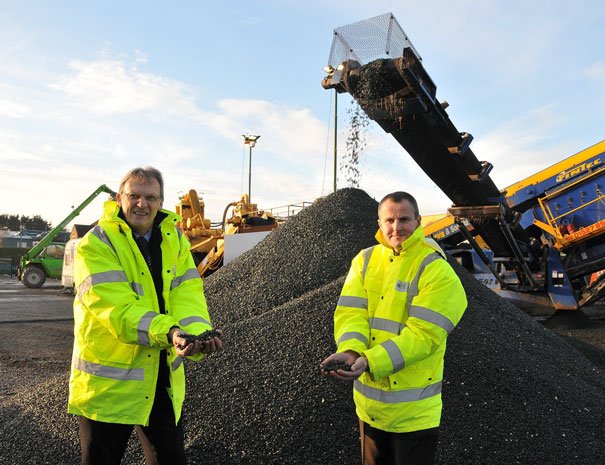
More than 4000 tonnes of road chippings, collected by the council following last year’s £2 million road surface dressing programme, will be cleaned and stored ready for re-use as part of this summer’s programme, helping the council save thousands of pounds and reduce its carbon footprint.
In previous years, chippings collected by road sweepers have had to be sent to landfill, costing the authority significant sums in landfill tax, but this year the council has hired in recently-developed, specialist equipment that will see the chippings cleaned and graded for re-use.
Councillor Chris Matthews, cabinet portfolio holder for infrastructure, highways and emergency planning at East Riding of Yorkshire Council, said: “By hiring in equipment and cleaning the chippings for reuse in this year’s scheme, the council is making savings on landfill tax and an overall saving on programme costs of around £26,000. Fewer lorry miles from the quarry and keeping emissions involved in the process of surface dressing to a minimum will also help reduce our carbon footprint.
“Ensuring the roads and infrastructure of the East Riding, as a whole, are in the best possible order long term is a top priority for the council and surface dressing provides a value-for-money and proactive approach by sealing roads, reducing reactive repair works and protecting the road network from winter ingress and frost damage.
“Surface dressing is in line with national initiatives for undertaking preventative works to reduce overall road maintenance costs.”
The cleaning process for the chippings, stored at Lissett and Middleton-on-the-Wolds, sees the material loaded into a hopper, over a grid to take out excessively oversized material. Chippings proceed to a log washer and under a belt magnet to remove any metallic waste, as the log washer removes all lightweight and vegetable matter.
The aggregate is then washed with high-power jets and screened into relevant sizes, the sand and silt proportion goes into a cyclone/classifier and the dirty water back into the settlement tank.
In the settlement tank, the water is flocculated to send the heavy dirt particles to the bottom and is pumped off to the centrifuge where it is separated and the clean water is reused in the system.
A loading shovel is then used to take the clean chippings to stock piles for reuse.
Surface dressing forms part of the council’s proactive approach to the maintenance of the 3,500km of highway network in the East Riding and takes place during the summer months every year on both urban and rural roads.
Surface dressing has four main purposes: to provide texture and skid resistance to an existing surface, to seal a road against water, to stop disintegration and to provide a uniform appearance for a patched road.
The surface dressing process is carried out by applying hot bitumen to the road, spreading a layer of stone chippings and forcing the chippings into the bitumen by roller. This embeds the chips but they are forced further into the bitumen by the constant running of traffic.
It is for this reason that you will find 10mph signs on newly surfaced roads. About 24 hours later the road is swept by mechanical sweeper to remove the excess chippings and then swept again after four to six weeks. The excess chippings are stockpiled ready for recycling in the following year’s programme to avoid waste.
Road markings are usually replaced within seven days after the loose chippings have gone, but again this is subject to the weather being fine.
This year’s £2m surface dressing programme will see around 600,000 square metres of highway resurfaced between May and August.


